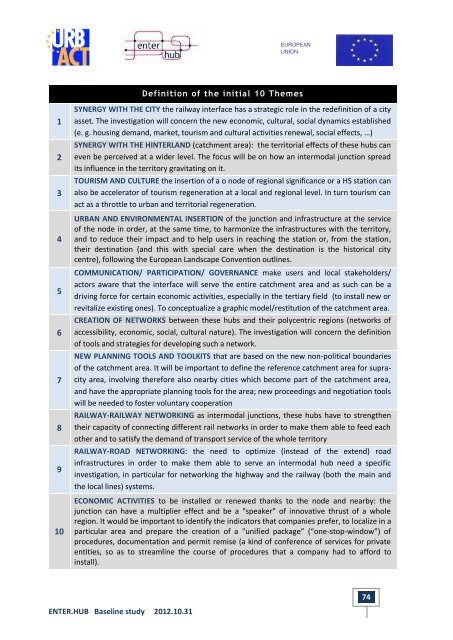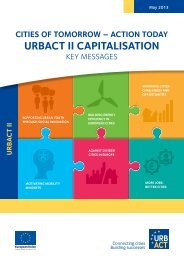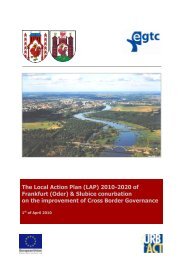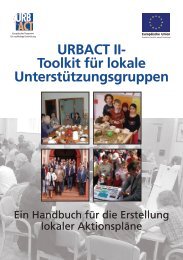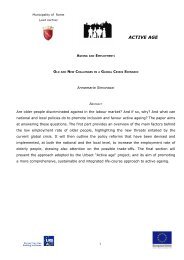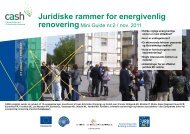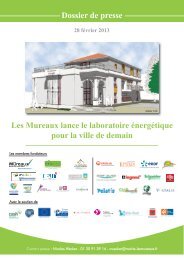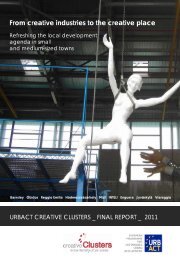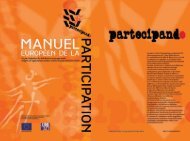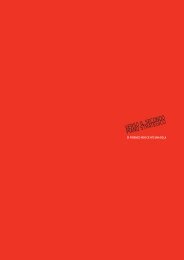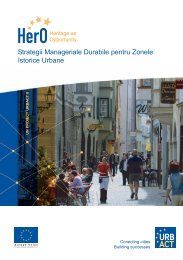ENTER.HUB_Baseline study PDF, 6 Mo - Urbact
ENTER.HUB_Baseline study PDF, 6 Mo - Urbact
ENTER.HUB_Baseline study PDF, 6 Mo - Urbact
You also want an ePaper? Increase the reach of your titles
YUMPU automatically turns print PDFs into web optimized ePapers that Google loves.
EUROPEAN<br />
UNION<br />
European Regional<br />
Development Fund<br />
Definition of the initial 10 Themes<br />
1<br />
2<br />
3<br />
4<br />
5<br />
6<br />
7<br />
8<br />
9<br />
10<br />
SYNERGY WITH THE CITY the railway interface has a strategic role in the redefinition of a city<br />
asset. The investigation will concern the new economic, cultural, social dynamics established<br />
(e. g. housing demand, market, tourism and cultural activities renewal, social effects, …)<br />
SYNERGY WITH THE HINTERLAND (catchment area): the territorial effects of these hubs can<br />
even be perceived at a wider level. The focus will be on how an intermodal junction spread<br />
its influence in the territory gravitating on it.<br />
TOURISM AND CULTURE the insertion of a o node of regional significance or a HS station can<br />
also be accelerator of tourism regeneration at a local and regional level. In turn tourism can<br />
act as a throttle to urban and territorial regeneration.<br />
URBAN AND ENVIRONMENTAL INSERTION of the junction and infrastructure at the service<br />
of the node in order, at the same time, to harmonize the infrastructures with the territory,<br />
and to reduce their impact and to help users in reaching the station or, from the station,<br />
their destination (and this with special care when the destination is the historical city<br />
centre), following the European Landscape Convention outlines.<br />
COMMUNICATION/ PARTICIPATION/ GOVERNANCE make users and local stakeholders/<br />
actors aware that the interface will serve the entire catchment area and as such can be a<br />
driving force for certain economic activities, especially in the tertiary field (to install new or<br />
revitalize existing ones). To conceptualize a graphic model/restitution of the catchment area.<br />
CREATION OF NETWORKS between these hubs and their polycentric regions (networks of<br />
accessibility, economic, social, cultural nature). The investigation will concern the definition<br />
of tools and strategies for developing such a network.<br />
NEW PLANNING TOOLS AND TOOLKITS that are based on the new non-political boundaries<br />
of the catchment area. It will be important to define the reference catchment area for supracity<br />
area, involving therefore also nearby cities which become part of the catchment area,<br />
and have the appropriate planning tools for the area; new proceedings and negotiation tools<br />
will be needed to foster voluntary cooperation<br />
RAILWAY-RAILWAY NETWORKING as intermodal junctions, these hubs have to strengthen<br />
their capacity of connecting different rail networks in order to make them able to feed each<br />
other and to satisfy the demand of transport service of the whole territory<br />
RAILWAY-ROAD NETWORKING: the need to optimize (instead of the extend) road<br />
infrastructures in order to make them able to serve an intermodal hub need a specific<br />
investigation, in particular for networking the highway and the railway (both the main and<br />
the local lines) systems.<br />
ECONOMIC ACTIVITIES to be installed or renewed thanks to the node and nearby: the<br />
junction can have a multiplier effect and be a "speaker" of innovative thrust of a whole<br />
region. It would be important to identify the indicators that companies prefer, to localize in a<br />
particular area and prepare the creation of a "unified package” (“one-stop-window”) of<br />
procedures, documentation and permit remise (a kind of conference of services for private<br />
entities, so as to streamline the course of procedures that a company had to afford to<br />
install).<br />
74<br />
<strong>ENTER</strong>.<strong>HUB</strong> <strong>Baseline</strong> <strong>study</strong> 2012.10.31


